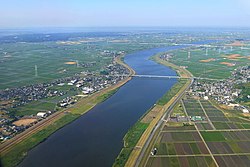Tone River
You can helpexpand this article with text translated fromthe corresponding articlein Japanese.(October 2018)Click [show] for important translation instructions.
|
| Tone River | |
|---|---|
 | |
 | |
| Native name | Lợi căn xuyên(Japanese) |
| Location | |
| Country | Japan |
| Physical characteristics | |
| Source | Mount Ōminakami |
| • location | Minakami, Gunma |
| • coordinates | 37°03′16″N139°06′05″E/ 37.05444°N 139.10139°E |
| • elevation | 1,831 m (6,007 ft) |
| Mouth | Pacific Ocean |
• location | Chōshi,Chiba |
• coordinates | 35°44′45″N140°51′07″E/ 35.74583°N 140.85194°E |
• elevation | 0 m (0 ft) |
| Length | 322 km (200 mi) |
| Basin size | 16,840 km2(6,500 sq mi) |
| Discharge | |
| • average | 256 m3/s (9,000 cu ft/s) |
TheTone River(Lợi căn xuyên,Tone-gawa)is a river in theKantō regionofJapan.It is 322 kilometers (200 mi) in length (the second longest in Japan after theShinano) and has a drainage area of 16,840 square kilometers (6,500 sq mi) (the largest in Japan). It is nicknamedBandō Tarō(Bản đông quá lang);Bandōis an obsolete alias of theKantō Region,andTarōis a popular given name for an oldest son.[1]It is regarded as one of the "Three Greatest Rivers" of Japan, the others being theYoshinoinShikokuand theChikugoinKyūshū.
Geography
[edit]The source of the Tone River is atMount Ōminakami(Lũ lụt lên núi) (1,831 meters (6,007 ft)) in theEchigo Mountains,which straddle the border betweenGunmaandNiigataPrefectures inJōshin'etsu Kōgen National Park.[1]The Tone gatherstributariesand pours into thePacific OceanatCape Inubō,ChoshiinChiba Prefecture.[2]
Tributaries
[edit]Major tributaries of the Tone River include theAgatsuma,Watarase,Kinu,Omoi,and theKokai River.TheEdo Riverbranches away from the river and flows intoTokyo Bay.
History
[edit]The Tone River was once known for its uncontrollable nature, and its route changed whenever floods occurred. It is hard to trace its ancient route, but it originally flowed intoTokyo Bayalong the route of the present-dayEdo River,and tributaries like theWataraseandKinuhad independent river systems. For the sake of water transportation and flood control, extensive construction began in the 17th century during theTokugawa shogunate,when the Kantō region became the political center of Japan.[3]The course of the river was significantly changed, and the present route of the river was determined during theMeiji period,[4]with the assistance of Dutch civil engineerAnthonie Rouwenhorst Mulder.[5]Its vast watershed is thus largely artificial.
Two ships of theImperial Japanese Navywere named after the river,oneofWorld War Ivintage andanotherfromWorld War II,thelead shipofits class.
Fukushima Daiichi nuclear disaster
[edit]As a result of theFukushima Daiichi nuclear disasterradioactive cesium concentrations of 110 becquerels per kilogram were found insilver crucian carp fishcaught in the Tone River in April 2012. The river is 180 kilometres (110 mi) from the Fukushima Daiichi Plant. Six fishery cooperatives and 10 towns along the river were asked to stop all shipments of fish caught in the Tone.[6]
Use
[edit]
The Tone River was an indispensable inland water link between the capitol atEdo,and later Tokyo, to the Pacific Ocean. It carried not only local products likesoy saucefromChoshi,but also products from theTōhoku region,in order to save time and to avoid risk in the open sea. With the advent of therailwayin the 19th century major shipping on the Tone quickly declined, and inland ports such asNoda,Sekiyado,now part of Noda,Nagareyama,andSawara,now part ofKatoridiminished in importance.[2]Today the river has severaldamsthat supply water for more than 30 million inhabitants of metropolitanTokyoand large-scale industrial areas such as theKeiyō Industrial Zone.
Rafting and kayaking
[edit]TheMinakamionsenarea in Gunma Prefecture is near the source for the Tone River and during the spring snow melt period, April–June, the river provides consistent grade 4 rapids (on theInternational Scale of River Difficulty) over a 12 kilometers (7.5 mi) stretch. The river provides some of the best white waterraftingandkayakingin Japan. The snow melt swells the river to grade 4 in spring; in the summer it is a gentle grade 2. The Momijikyo section has 7 grade 3-4 rapids for 1 kilometer (0.62 mi) and is 12 kilometers (7.5 mi) long in total.[7]
Cycling
[edit]The Tone River is home to Japan's longest car free cycling path. At over 220km long the Tone River Cycling Road lợi căn xuyên サイクリングロード starts in Shibukawa City, Gunma and runs all the way to Choshi City, Chiba. The total route is over 230km but the final 10km or so into Choshi is on a road. The remaining 220km is on detached cycling paths high up on the river bank with great views of mountains while in Gunma and large rice fields and agriculture as you approach the ocean.[8]
Image gallery
[edit]-
Tone River at Narita and Kawachi
-
Kurihashi Water Level Observatory (June 2005)
-
View of Tone River mouth andChōshicity from air
References
[edit]- ^ab"Lợi căn xuyên の giới thiệu"(in Japanese). Ministry of Land, Infrastructure, Transport and Tourism, Japan.Retrieved2019-10-16.
- ^ab"Tone River".Encyclopædia Britannica.Chicago, Ill.: Encyclopædia Britannica. 2012.Retrieved2012-12-19.
- ^"Edo-jidai no Tonegawa"(PDF)(in Japanese). Ministry of Land, Infrastructure, Transport and Tourism, Japan.Retrieved2019-10-16.
- ^"Tonegawa kindai kaishū no hajimari"(PDF)(in Japanese). Ministry of Land, Infrastructure, Transport and Tourism, Japan.Retrieved2019-10-16.
- ^"Crown Prince Naruhito, Dutch prince visit canal in Chiba Pref".AP. 14 September 2010. Archived fromthe originalon 2014-03-21.
- ^JAIF (26 April 2012)Earthquake Report 412: Cesium contaminated fish found in Tone riverArchived2012-05-22 at theWayback Machine
- ^Minakami Rafting
- ^"The Tone River Cycling Road | Japan's Longest Car Free Bike Route".18 October 2021.
External links
[edit]![]() Media related toTone Riverat Wikimedia Commons
Media related toTone Riverat Wikimedia Commons






